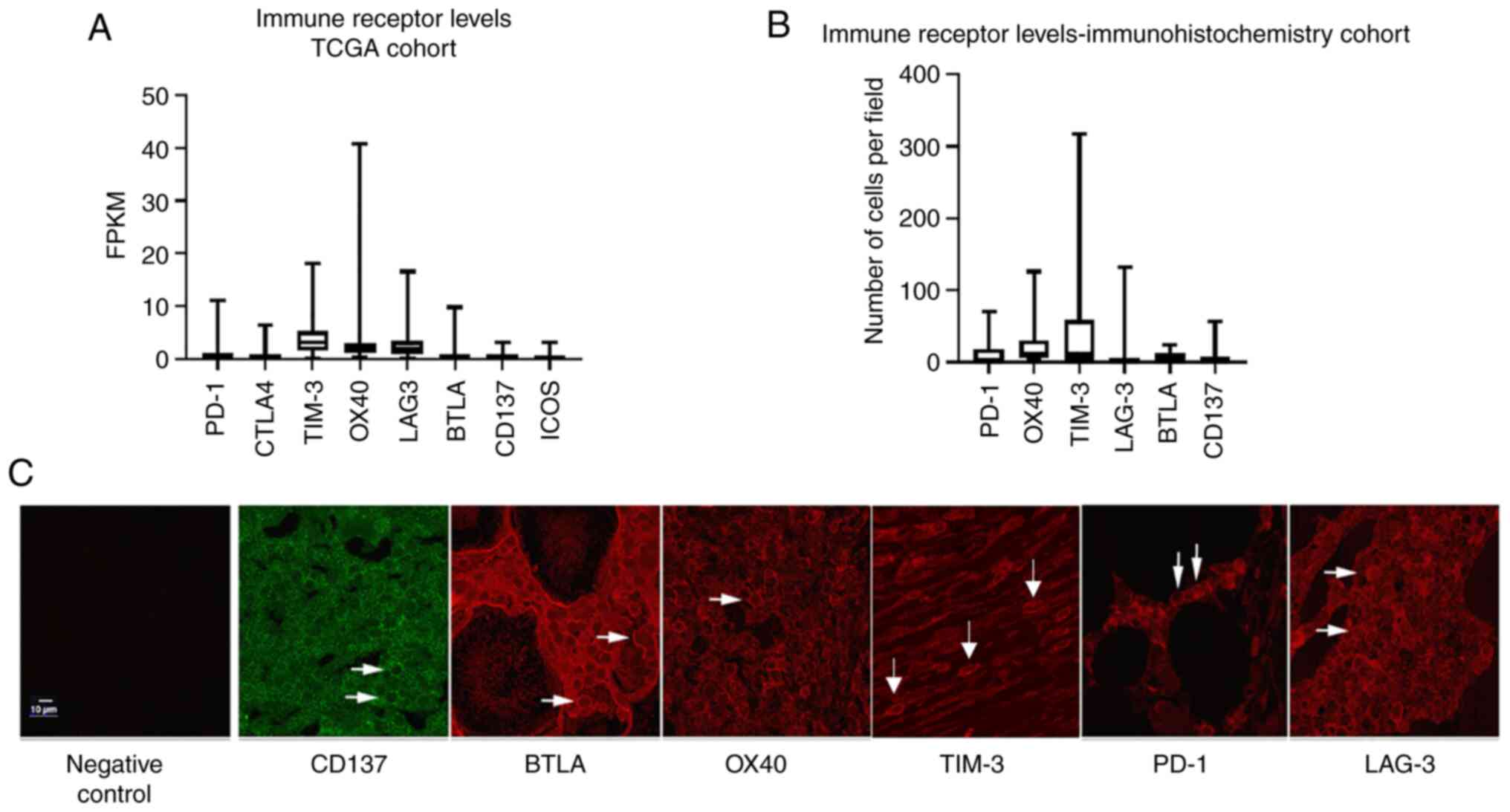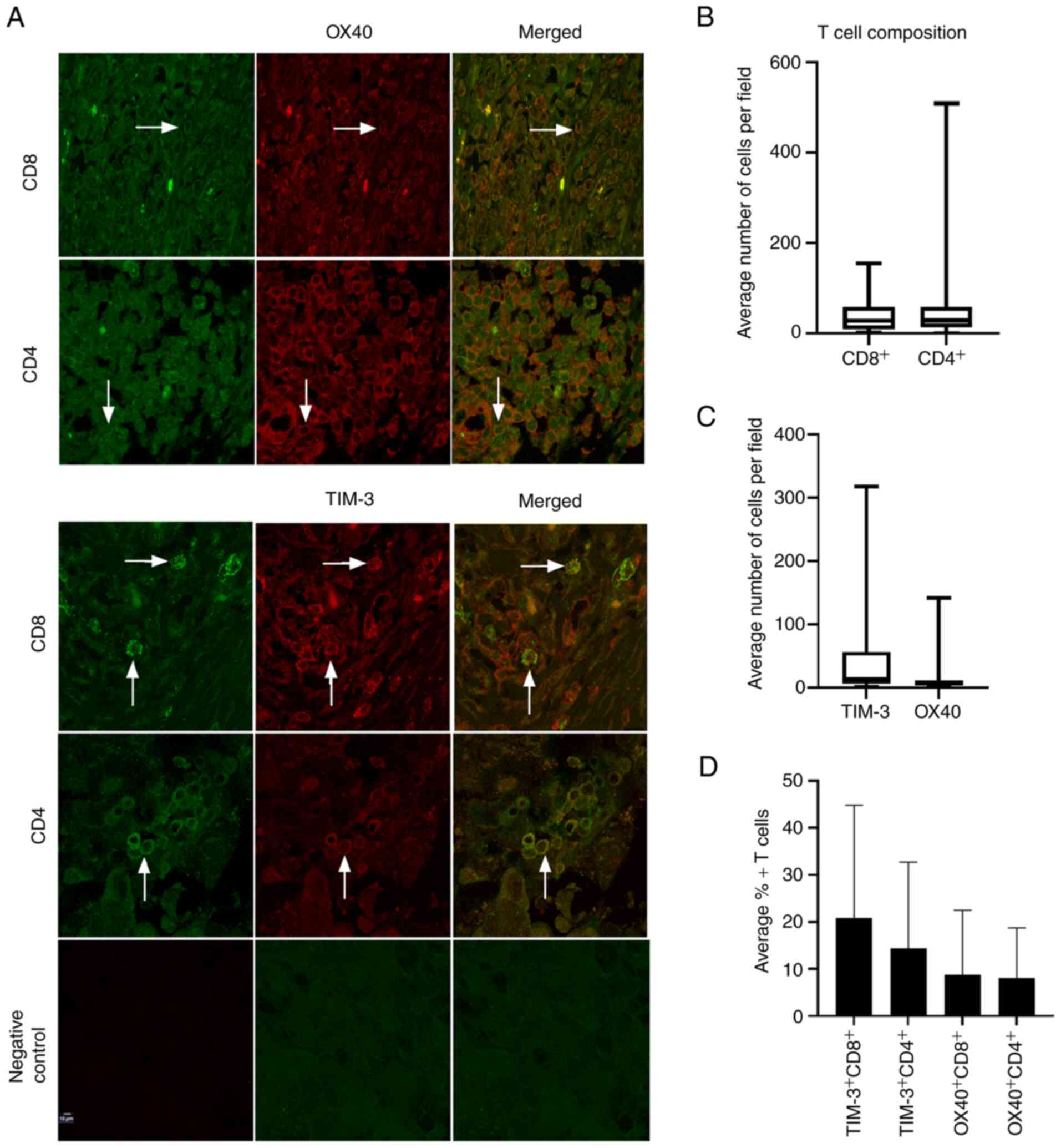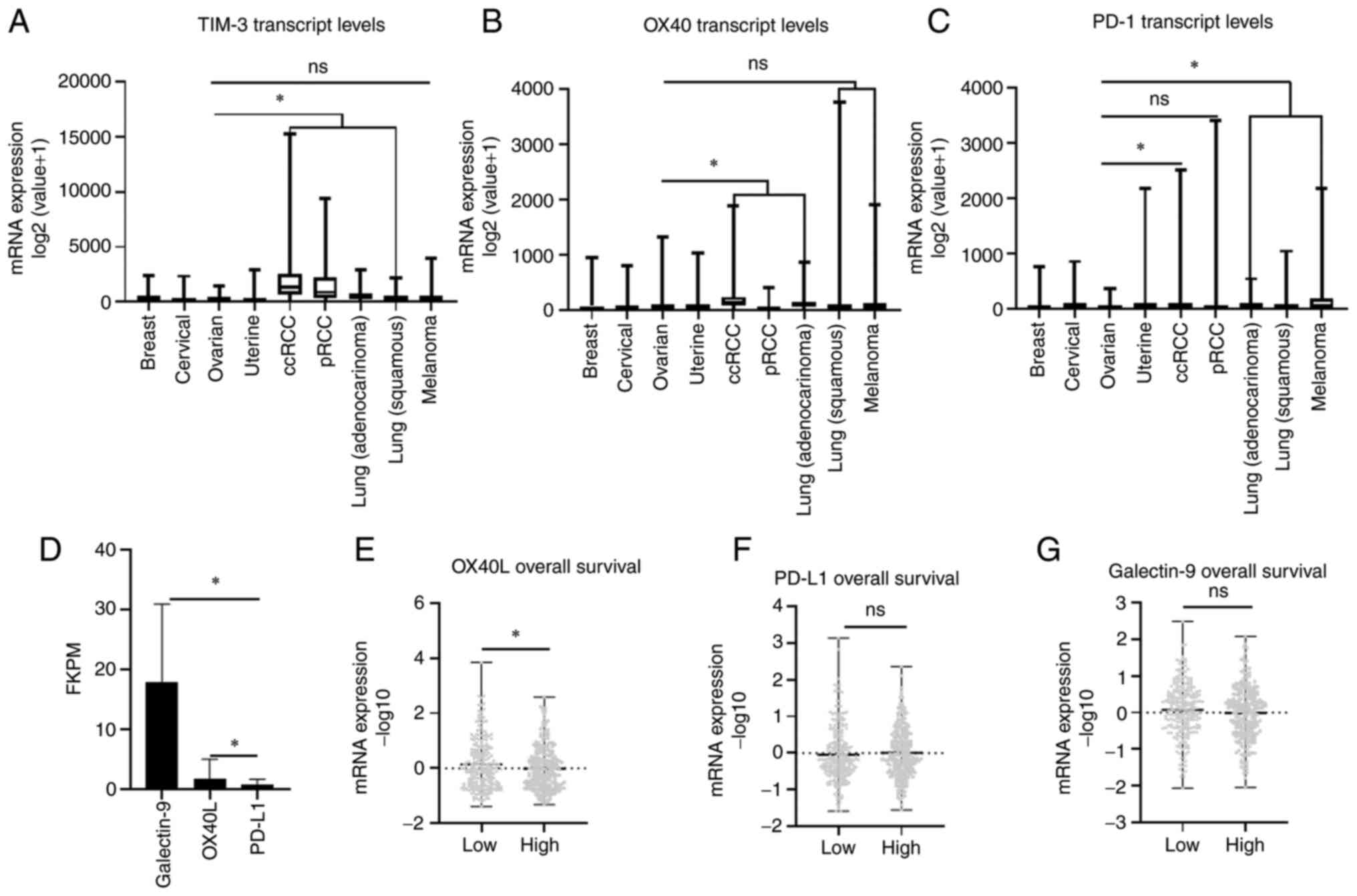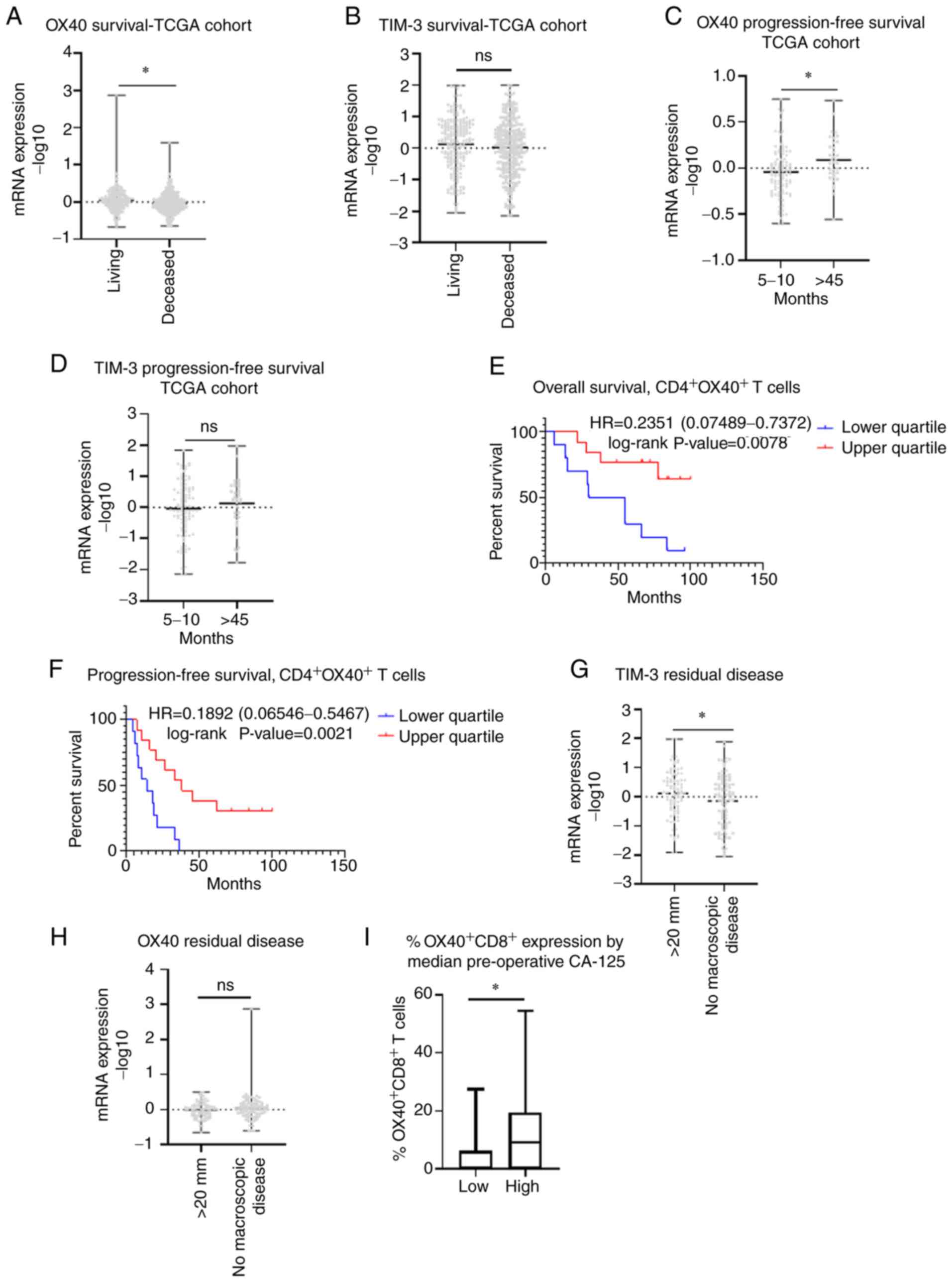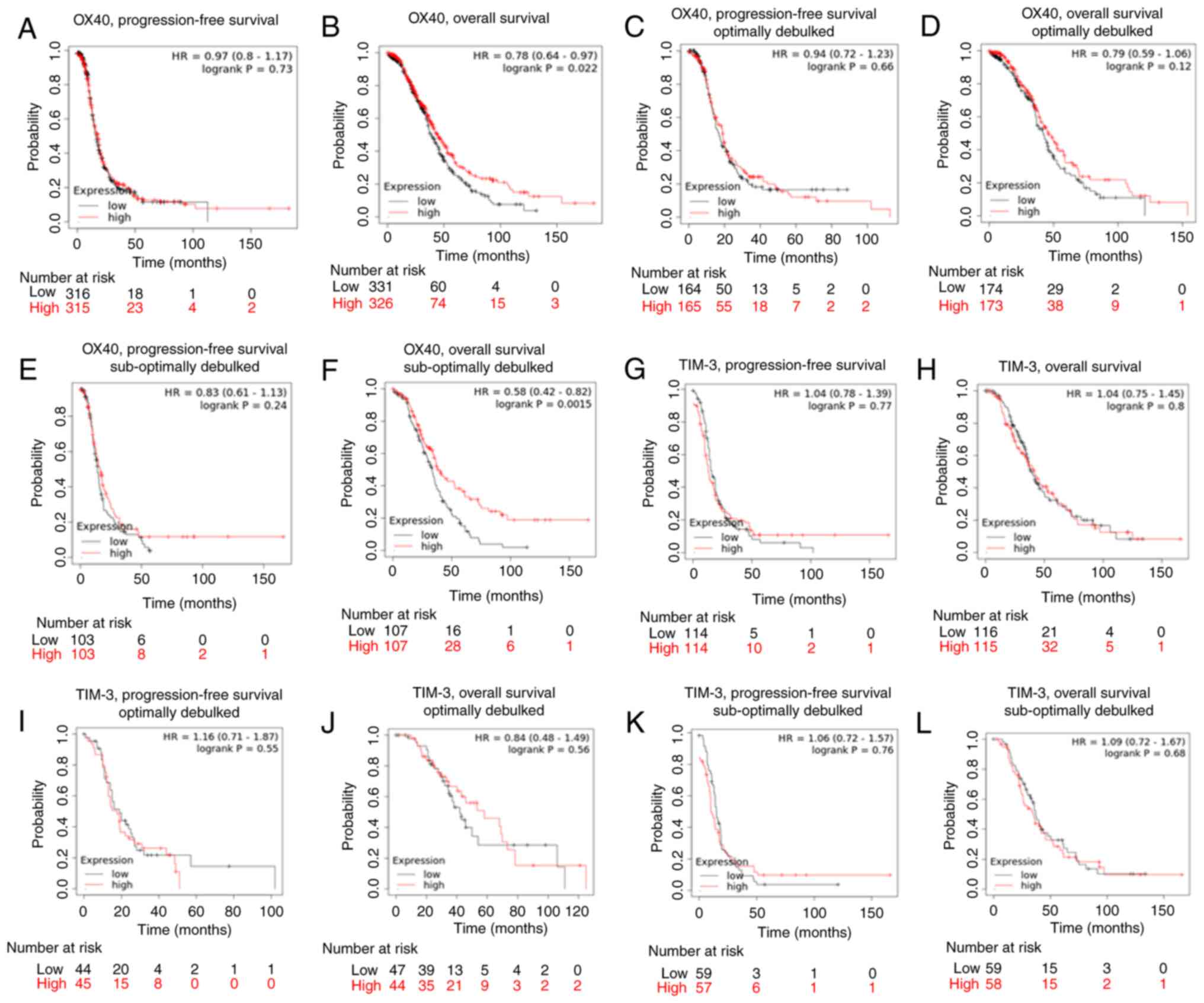|
1
|
American Cancer Society, . Key Statistics
for Ovarian Cancer. https://www.cancer.org/cancer/ovarian-cancer/about/key-statistics.htmlFebruary
1–2022PubMed/NCBI
|
|
2
|
Torre LA, Trabert B, DeSantis CE, Miller
KD, Samimi G, Runowicz CD, Gaudet MM, Jemal A and Siegel RL:
Ovarian cancer statistics, 2018. CA Cancer J Clin. 68:284–296.
2018. View Article : Google Scholar : PubMed/NCBI
|
|
3
|
Labidi-Galy SI, Papp E, Hallberg D,
Niknafs N, Adleff V, Noe M, Bhattacharya R, Novak M, Jones S,
Phallen J, et al: High grade serous ovarian carcinomas originate in
the fallopian tube. Nat Commun. 8:10932017. View Article : Google Scholar : PubMed/NCBI
|
|
4
|
Morgan RD, Clamp AR, Evans DGR, Edmondson
RJ and Jayson GC: PARP inhibitors in platinum-sensitive high-grade
serous ovarian cancer. Cancer Chemother Pharmacol. 81:647–658.
2018. View Article : Google Scholar : PubMed/NCBI
|
|
5
|
Selvakumaran M, Pisarcik DA, Bao R, Yeung
AT and Hamilton TC: Enhanced cisplatin cytotoxicity by disturbing
the nucleotide excision repair pathway in ovarian cancer cell
lines. Cancer Res. 63:1311–1316. 2003.PubMed/NCBI
|
|
6
|
Rossi L, Verrico M, Zaccarelli E, Papa A,
Colonna M, Strudel M, Vici P, Bianco V and Tomao F: Bevacizumab in
ovarian cancer: A critical review of phase III studies. Oncotarget.
8:12389–12405. 2017. View Article : Google Scholar : PubMed/NCBI
|
|
7
|
Liu G, Yang D, Sun Y, Shmulevich I, Xue F,
Sood AK and Zhang W: Differing clinical impact of BRCA1 and BRCA2
mutations in serous ovarian cancer. Pharmacogenomics. 13:1523–1535.
2012. View Article : Google Scholar : PubMed/NCBI
|
|
8
|
Earl H, Molica S and Rutkowski P:
Spotlight on landmark oncology trials: The latest evidence and
novel trial designs. BMC Med. 15:1112017. View Article : Google Scholar : PubMed/NCBI
|
|
9
|
Lieber S, Reinartz S, Raifer H,
Finkernagel F, Dreyer T, Bronger H, Jansen JM, Wagner U, Worzfeld
T, Müller R and Huber M: Prognosis of ovarian cancer is associated
with effector memory CD8+ T cell accumulation in
ascites, CXCL9 levels and activation-triggered signal transduction
in T cells. Oncoimmunology. 7:e14246722018. View Article : Google Scholar : PubMed/NCBI
|
|
10
|
Hamanishi J, Mandai M and Konishi I:
Immune checkpoint inhibition in ovarian cancer. Int Immunol.
28:339–348. 2016. View Article : Google Scholar : PubMed/NCBI
|
|
11
|
Webb JR, Milne K, Kroeger DR and Nelson
BH: PD-L1 expression is associated with tumor-infiltrating T cells
and favorable prognosis in high-grade serous ovarian cancer.
Gynecol Oncol. 141:293–302. 2016. View Article : Google Scholar : PubMed/NCBI
|
|
12
|
Drakes ML, Mehrotra S, Aldulescu M, Potkul
RK, Liu Y, Grisoli A, Joyce C, O'Brien TE, Stack MS and Stiff PJ:
Stratification of ovarian tumor pathology by expression of
programmed cell death-1 (PD-1) and PD-ligand-1 (PD-L1) in ovarian
cancer. J Ovarian Res. 11:432018. View Article : Google Scholar : PubMed/NCBI
|
|
13
|
Rodriguez GM, Galpin KJC, McCloskey CW and
Vanderhyden BC: The tumor microenvironment of epithelial ovarian
cancer and its influence on response to immunotherapy. Cancers
(Basel). 10:2422018. View Article : Google Scholar : PubMed/NCBI
|
|
14
|
Zhang L, Conejo-Garcia JR, Katsaros D,
Gimotty PA, Massobrio M, Regnani G, Makrigiannakis A, Gray H,
Schlienger K, Liebman MN, et al: Intratumoral T cells, recurrence,
and survival in epithelial ovarian cancer. N Engl J Med.
348:203–213. 2003. View Article : Google Scholar : PubMed/NCBI
|
|
15
|
Santoiemma PP and Powell DJ Jr: Tumor
infiltrating lymphocytes in ovarian cancer. Cancer Biol Ther.
16:807–820. 2015. View Article : Google Scholar : PubMed/NCBI
|
|
16
|
James NE, Woodman M, DiSilvestro PA and
Ribeiro JR: The perfect combination: Enhancing Patient response to
PD-1-based therapies in epithelial ovarian cancer. Cancers (Basel).
12:21502020. View Article : Google Scholar : PubMed/NCBI
|
|
17
|
Ghisoni E, Imbimbo M, Zimmermann S and
Valabrega G: Ovarian cancer immunotherapy: Turning up the heat. Int
J Mol Sci. 20:29272019. View Article : Google Scholar : PubMed/NCBI
|
|
18
|
Torphy RJ, Schulick RD and Zhu Y: Newly
emerging immune checkpoints: Promises for future cancer therapy.
Int J Mol Sci. 18:26422017. View Article : Google Scholar : PubMed/NCBI
|
|
19
|
Ritthipichai K, Haymaker CL, Martinez M,
Aschenbrenner A, Yi X, Zhang M, Kale C, Vence LM, Roszik J,
Hailemichael Y, et al: Multifaceted role of BTLA in the control of
CD8+ T-cell fate after antigen encounter. Clin Cancer
Res. 23:6151–6164. 2017. View Article : Google Scholar : PubMed/NCBI
|
|
20
|
Flynn R, Hutchinson T, Murphy KM, Ware CF,
Croft M and Salek-Ardakani S: CD8 T cell memory to a viral pathogen
requires trans cosignaling between HVEM and BTLA. PLoS One.
8:e779912013. View Article : Google Scholar : PubMed/NCBI
|
|
21
|
Simon T and Bromberg JS: BTLA+
dendritic cells: The regulatory T cell force awakens. Immunity.
45:956–958. 2016. View Article : Google Scholar : PubMed/NCBI
|
|
22
|
Marin-Acevedo JA, Dholaria B, Soyano AE,
Knutson KL, Chumsri S and Lou Y: Next generation of immune
checkpoint therapy in cancer: New developments and challenges. J
Hematol Oncol. 11:392018. View Article : Google Scholar : PubMed/NCBI
|
|
23
|
Zak KM, Grudnik P, Magiera K, Dömling A,
Dubin G and Holak TA: Structural biology of the immune checkpoint
receptor PD-1 and its ligands PD-L1/PD-L2. Structure. 25:1163–1174.
2017. View Article : Google Scholar : PubMed/NCBI
|
|
24
|
Han Y, Liu D and Li L: PD-1/PD-L1 pathway:
Current researches in cancer. Am J Cancer Res. 10:727–742.
2020.PubMed/NCBI
|
|
25
|
Makkouk A, Chester C and Kohrt HE:
Rationale for anti-CD137 cancer immunotherapy. Eur J Cancer.
54:112–119. 2016. View Article : Google Scholar : PubMed/NCBI
|
|
26
|
Snell LM, Lin GH, McPherson AJ, Moraes TJ
and Watts TH: T-cell intrinsic effects of GITR and 4-1BB during
viral infection and cancer immunotherapy. Immunol Rev. 244:197–217.
2011. View Article : Google Scholar : PubMed/NCBI
|
|
27
|
Bauché D, Joyce-Shaikh B, Jain R, Grein J,
Ku KS, Blumenschein WM, Ganal-Vonarburg SC, Wilson DC, McClanahan
TK, Malefyt RW, et al: LAG3+ regulatory T cells restrain
interleukin-23-Producing CX3CR1+ gut-resident
macrophages during group 3 innate lymphoid cell-driven colitis.
Immunity. 49:342–352.e5. 2018. View Article : Google Scholar : PubMed/NCBI
|
|
28
|
Workman CJ, Cauley LS, Kim IJ, Blackman
MA, Woodland DL and Vignali DAA: Lymphocyte activation gene-3
(CD223) regulates the size of the expanding T cell population
following antigen activation in vivo. J Immunol. 172:5450–5455.
2004. View Article : Google Scholar : PubMed/NCBI
|
|
29
|
Grosso JF, Kelleher CC, Harris TJ, Maris
CH, Hipkiss EL, De Marzo A, Anders R, Netto G, Getnet D, Bruno TC,
et al: LAG-3 regulates CD8+ T cell accumulation and
effector function in murine self- and tumor-tolerance systems. J
Clin Invest. 117:3383–3392. 2007. View Article : Google Scholar : PubMed/NCBI
|
|
30
|
Willoughby J, Griffiths J, Tews I and
Cragg MS: OX40: Structure and function-What questions remain? Mol
Immunol. 83:13–22. 2017. View Article : Google Scholar : PubMed/NCBI
|
|
31
|
Buchan SL, Rogel A and Al-Shamkhani A: The
immunobiology of CD27 and OX40 and their potential as targets for
cancer immunotherapy. Blood. 131:39–48. 2018. View Article : Google Scholar : PubMed/NCBI
|
|
32
|
Jayaraman P, Jacques MK, Zhu C, Steblenko
KM, Stowell BL, Madi A, Anderson AC, Kuchroo VK and Behar SM: TIM3
Mediates T Cell Exhaustion during Mycobacterium tuberculosis
infection. PLoS Pathog. 12:e10054902016. View Article : Google Scholar : PubMed/NCBI
|
|
33
|
Anderson AC, Joller N and Kuchroo VK:
Lag-3, Tim-3, and TIGIT: Co-inhibitory receptors with specialized
functions in immune regulation. Immunity. 44:989–1004. 2016.
View Article : Google Scholar : PubMed/NCBI
|
|
34
|
Xiao Z, Mayer AT, Nobashi TW and Gambhir
SS: ICOS Is an Indicator of T-cell-mediated response to cancer
immunotherapy. Cancer Res. 80:3023–3032. 2020. View Article : Google Scholar : PubMed/NCBI
|
|
35
|
Solinas C, Gu-Trantien C and Willard-Gallo
K: The rationale behind targeting the ICOS-ICOS ligand
costimulatory pathway in cancer immunotherapy. ESMO Open.
5:e0005442020. View Article : Google Scholar : PubMed/NCBI
|
|
36
|
Hosseini A, Gharibi T, Marofi F, Babaloo Z
and Baradaran B: CTLA-4: From mechanism to autoimmune therapy. Int
Immunopharmacol. 80:1062212020. View Article : Google Scholar : PubMed/NCBI
|
|
37
|
Wang J, Sanmamed MF, Datar I, Su TT, Ji L,
Sun J, Chen L, Chen Y, Zhu G, Yin W, et al: Fibrinogen-like Protein
1 Is a Major Immune Inhibitory Ligand of LAG-3. Cell.
176:334–347.e12. 2019. View Article : Google Scholar : PubMed/NCBI
|
|
38
|
Andrews LP, Marciscano AE, Drake CG and
Vignali DA: LAG3 (CD223) as a cancer immunotherapy target. Immunol
Rev. 276:80–96. 2017. View Article : Google Scholar : PubMed/NCBI
|
|
39
|
Team RC: R: A language and environment for
statistical computing. 2013. http://www.R-project.org/June 15–2020
|
|
40
|
Morgan M and Davis S: R: A language and
environment for statistical computing. [Internet]. NIH/NCI Genomic
Data Commons Access. https://bioconductor.org/packages/GenomicDataCommonsJune
15–2020
|
|
41
|
Gyorffy B, Lánczky A and Szállási Z:
Implementing an online tool for genome-wide validation of
survival-associated biomarkers in ovarian-cancer using microarray
data from 1287 patients. Endocr Relat Cancer. 19:197–208. 2012.
View Article : Google Scholar : PubMed/NCBI
|
|
42
|
Rådestad E, Klynning C, Stikvoort A,
Mogensen O, Nava S, Magalhaes I and Uhlin M: Immune profiling and
identification of prognostic immune-related risk factors in human
ovarian cancer. Oncoimmunology. 8:e15357302019. View Article : Google Scholar : PubMed/NCBI
|
|
43
|
Fucikova J, Rakova J, Hensler M, Kasikova
L, Belicova L, Hladikova K, Truxova I, Skapa P, Laco J, Pecen L, et
al: TIM-3 dictates functional orientation of the immune infiltrate
in ovarian cancer. Clin Cancer Res. 25:4820–4831. 2019. View Article : Google Scholar : PubMed/NCBI
|
|
44
|
Ramser M, Eichelberger S, Däster S,
Weixler B, Kraljević M, Mechera R, Tampakis A, Delko T, Güth U,
Stadlmann S, et al: High OX40 expression in recurrent ovarian
carcinoma is indicative for response to repeated chemotherapy. BMC
Cancer. 18:4252018. View Article : Google Scholar : PubMed/NCBI
|
|
45
|
Guo Z, Wang X, Cheng D, Xia Z, Luan M and
Zhang S: PD-1 blockade and OX40 triggering synergistically protects
against tumor growth in a murine model of ovarian cancer. PLoS One.
9:e893502014. View Article : Google Scholar : PubMed/NCBI
|















